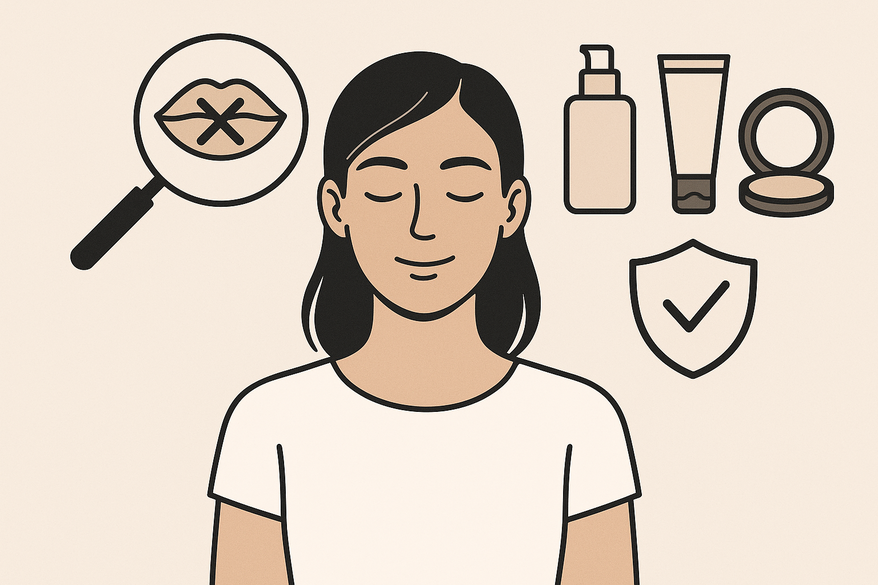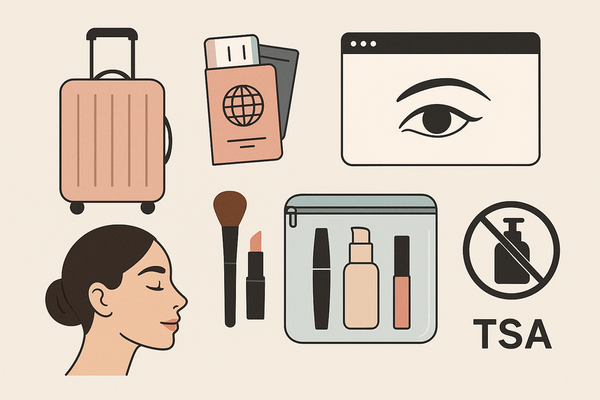Debunking Makeup Misconceptions: Essential Facts for Your Beauty Routine
Debunking makeup misconceptions helps you choose products wisely, protect skin health, and boost confidence. Discover factual insights for smarter routines.

Estimated reading time: 10 minutes
Key Takeaways
- Myths vs. Science: Many makeup beliefs stem from marketing or anecdote rather than clinical research.
- Ingredient Truths: Both natural and synthetic ingredients undergo safety testing; non-comedogenic formulas prevent breakouts.
- Application Tips: Correct shade matching, tool sanitation, and proper layering lead to flawless results.
- Expert Insights: Dermatologists, cosmetic chemists, and makeup artists offer evidence-based guidance.
- Consumer Empowerment: Use credential checks, INCI lists, and patch tests to avoid misleading beauty claims.
Table of Contents
- Section 1: Defining the Scope of Makeup Misconceptions
- Section 2: Top 7 Common Makeup Misconceptions – Myth vs. Fact
- Section 3: The Impact of Misinformation on Consumers
- Section 4: How to Identify and Avoid Misleading Makeup Information
- Section 5: Expert Opinions and Scientific Evidence
- Section 6: Practical Consumer Advice for Flawless, Informed Makeup Use
- Conclusion
- Additional Resources
Section 1: Defining the Scope of Makeup Misconceptions
Makeup misconceptions are inaccurate beliefs—often rooted in anecdote rather than science—about product safety, ingredient efficacy, application techniques, and long-term skin effects. They typically fall into three categories:
- Ingredient Myths: “Harmful chemicals” always lurk in cosmetics; “natural” always equals safe.
- Application Myths: Strict layering rules; erroneous shade-matching advice.
- Long-Term Effects Myths: Claims that makeup causes premature aging or permanent skin damage.
Most false claims come from marketing hype and viral trends rather than lab tests or dermatology. Clearing up these ideas protects skin health, saves money, and boosts your confidence.
Section 2: Top 7 Common Makeup Misconceptions – Myth vs. Fact
Here are seven pervasive myths, their origins, and the real facts backed by industry testing and skin science:
- “Expensive makeup is always better.”
Origin: Luxury branding and high price tags.
Fact: Formula quality matters most—drugstore brands can match luxury lines in pigment, emollients, and safety testing. Price often reflects packaging and marketing.
Research: ClothesColorGuide | Makeup by Kiley Smith | Debunking Common Makeup Myths - “Makeup causes acne.”
Origin: Personal stories blaming foundation or concealer.
Fact: Acne is driven by pore congestion, bacteria, and hormones. Non-comedogenic, oil-free formulas plus clean brushes prevent most breakouts.
Research: Makeup by Kiley Smith - “Natural ingredients are always safer.”
Origin: Clean beauty marketing.
Fact: Both natural and synthetic ingredients undergo rigorous safety tests; allergens can exist in herbs as well as lab-made actives.
Research: ClothesColorGuide - “Pumping your mascara wand retrieves more product.”
Origin: Trying to squeeze out every drop.
Fact: Pumping traps air inside the tube, drying the formula faster and raising bacterial risk.
Research: ClothesColorGuide - “Red lipstick suits only certain skin tones.”
Origin: Oversimplified beauty guides.
Fact: All skin tones can rock red—choose cool blue-based reds or warm orange-based reds to match your undertone.
Research: ClothesColorGuide | Makeup by Kiley Smith - “Matte lipsticks are always drying.”
Origin: Early matte formulas used waxy bases.
Fact: Modern mattes include hyaluronic acid, glycerin, or emollients—they hydrate while staying transfer-resistant.
Research: Makeup by Kiley Smith - “You shouldn’t wear makeup daily.”strong>
Origin: Fear of clogged pores and breakouts.
Fact: Daily makeup is safe with proper nightly removal, double-cleansing, and sanitized tools. Non-comedogenic products support healthy skin.
Research: ClothesColorGuide
Section 3: The Impact of Misinformation on Consumers
Misinformation in the beauty world often comes from marketing hype, influencer posts, and viral social media trends. These stories spread fast but frequently lack scientific proof. Real-world effects include:
- Wasted Spending – Buying hype-driven products you never use.
- Poor Skin Routines – Using formulas that irritate or dry out skin.
- Lowered Self-Esteem – Feeling “not good enough” if you don’t follow every trend.
- Unhealthy Standards – Chasing unrealistic looks that harm confidence.
L’Oréal data shows routine myths make people add unnecessary steps or skip key ones like SPF. Psychologists note confirmation bias makes us trust claims that fit our fears, and decision fatigue sets in when too many beauty “rules” compete for attention.
Section 4: How to Identify and Avoid Misleading Makeup Information
Use these four tips to spot false beauty claims:
- Verify Credentials
Seek licensed dermatologists, certified makeup artists, or cosmetic chemists. Check for degrees, board certifications, or industry experience on their profiles. - Scrutinize Product Claims
Read the INCI list (full ingredient list). Avoid “miracle” or “overnight” language without study references. Look for peer-reviewed clinical tests or precise percentage details on actives. - Consult Professionals
Book a patch test or virtual consultation with a skincare specialist. Use their advice to select formulas suited to your skin type. - Cross-Reference Multiple Sources
Compare information from ClothesColorGuide and Makeup by Kiley Smith. Check peer-reviewed journals or AAD guidelines. Learn tool usage from the Makeup Check AI Tutorial.
Section 5: Expert Opinions and Scientific Evidence
Insights from leading professionals confirm or bust these myths:
Dermatologist Insights (Ingredient Safety & Skin Health)
- Natural vs. Synthetic: Both can cause irritation or benefit skin; compatibility is individual.
- Daily SPF: Always wear broad-spectrum sunscreen under makeup to prevent UV-induced aging.
- Tool Sanitation: Clean brushes and sponges weekly to reduce bacteria and prevent breakouts.
- Sources: ClothesColorGuide, Makeup by Kiley Smith
Cosmetic Chemist Notes (Formula Stability & Efficacy)
Emollients, Humectants, Preservatives:
- Emollients smooth skin and improve spread (e.g., isododecane).
- Humectants draw moisture into skin (e.g., glycerin).
- Preservatives prevent mold and bacteria (e.g., phenoxyethanol).
- Safe Actives: Retinol up to 1%; AHAs like glycolic acid at 5–10% for daily use.
- Example INCI for non-comedogenic foundation: Aqua, Cyclopentasiloxane, Glycerin, Dimethicone, Iron Oxides, Phenoxyethanol, Caprylyl Glycol.
Professional Makeup Artist Tips (Application & Color Theory)
- Foundation Matching: Test along your jawline or neck, not the back of your hand.
- Color Theory:
– Warm undertones pair with yellow or peach primers.
– Cool undertones pair with pink or lavender primers. - Customized Techniques: Highlight jawline and cheekbones based on face shape, not fixed “rules.”
- Source: ClothesColorGuide
Section 6: Practical Consumer Advice for Flawless, Informed Makeup Use
Follow these actionable steps to keep myths at bay:
Patch Test Protocol
- Apply a small dot of product on your inner forearm.
- Wait 24–48 hours for redness or itching.
- Discard if you see a reaction.
Product Selection Checklist
- Skin Type: oily, dry, or combination.
- Lifestyle Needs: long-wear vs. breathable.
- Ingredient Sensitivities: fragrance-free, non-comedogenic, hypoallergenic.
Hygiene Best Practices
- Clean brushes weekly with a microbiology-approved cleanser.
- Discard mascara after 3–6 months; replace foundation after 12–18 months.
Routine Maintenance
- Remove makeup nightly with oil-based cleanser followed by foam or gel wash.
- Double-cleanse if you wear waterproof or long-wear cosmetics.
Ongoing Education
- Subscribe to AAD newsletters and cosmetology journals.
- Follow peer-reviewed beauty science blogs like ClothesColorGuide and Makeup by Kiley Smith.
- Attend virtual masterclasses from certified experts.
Conclusion
Debunking makeup misconceptions unlocks smarter, safer beauty routines. By clearing myths, you save money, keep your skin healthy, and boost self-esteem. You also gain the creative freedom to express yourself without unnecessary worry. Share your own makeup myths and experiences in the comments below, and bookmark this guide as your fact-based beauty check.
Additional Resources
- Makeup Myths Debunked: Separating Fact from Fiction
- Makeup Myths Debunked by a Professional Makeup Artist
- L’Oréal Paris – Makeup Routine Myths
- American Academy of Dermatology (AAD)
- Journal of Cosmetic Dermatology
- Debunking Common Makeup Myths
- Makeup Check AI Tutorial
FAQ
- Q: Can I trust “clean” or “natural” beauty labels? A: Look for transparency—read the full INCI list and check for peer-reviewed safety tests. “Natural” doesn’t always mean non-irritating.
- Q: How often should I sanitize my makeup brushes? A: Weekly cleaning with a microbiology-approved cleanser helps prevent bacterial buildup and breakouts.
- Q: Is it safe to layer multiple makeup products every day? A: Yes—provided you remove everything thoroughly at night, double-cleanse, and use non-comedogenic formulas.
- Q: How do I know if a product is non-comedogenic? A: Check the label or ingredient list for terms like “non-comedogenic.” Look for oil-free and lightweight emollients in the INCI.
- Q: What’s the best way to test a new foundation shade? A: Swatch along your jawline or neck in natural light. Give the formula a minute to settle before judging the match.




